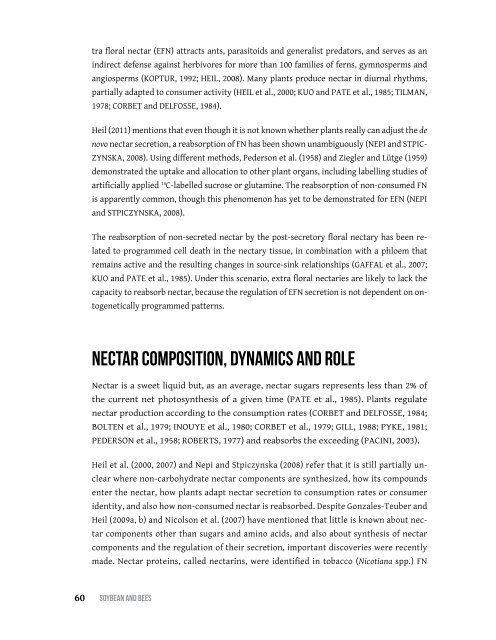Soybean and Bees
Create successful ePaper yourself
Turn your PDF publications into a flip-book with our unique Google optimized e-Paper software.
tra floral nectar (EFN) attracts ants, parasitoids <strong>and</strong> generalist predators, <strong>and</strong> serves as an<br />
indirect defense against herbivores for more than 100 families of ferns, gymnosperms <strong>and</strong><br />
angiosperms (Koptur, 1992; Heil, 2008). Many plants produce nectar in diurnal rhythms,<br />
partially adapted to consumer activity (Heil et al., 2000; Kuo <strong>and</strong> Pate et al., 1985; Tilman,<br />
1978; Corbet <strong>and</strong> Delfosse, 1984).<br />
Heil (2011) mentions that even though it is not known whether plants really can adjust the de<br />
novo nectar secretion, a reabsorption of FN has been shown unambiguously (Nepi <strong>and</strong> Stpiczynska,<br />
2008). Using different methods, Pederson et al. (1958) <strong>and</strong> Ziegler <strong>and</strong> Lütge (1959)<br />
demonstrated the uptake <strong>and</strong> allocation to other plant organs, including labelling studies of<br />
artificially applied 14 C-labelled sucrose or glutamine. The reabsorption of non-consumed FN<br />
is apparently common, though this phenomenon has yet to be demonstrated for EFN (Nepi<br />
<strong>and</strong> Stpiczynska, 2008).<br />
The reabsorption of non-secreted nectar by the post-secretory floral nectary has been related<br />
to programmed cell death in the nectary tissue, in combination with a phloem that<br />
remains active <strong>and</strong> the resulting changes in source-sink relationships (Gaffal et al., 2007;<br />
Kuo <strong>and</strong> Pate et al., 1985). Under this scenario, extra floral nectaries are likely to lack the<br />
capacity to reabsorb nectar, because the regulation of EFN secretion is not dependent on ontogenetically<br />
programmed patterns.<br />
Nectar composition, dynamics <strong>and</strong> role<br />
Nectar is a sweet liquid but, as an average, nectar sugars represents less than 2% of<br />
the current net photosynthesis of a given time (Pate et al., 1985). Plants regulate<br />
nectar production according to the consumption rates (Corbet <strong>and</strong> Delfosse, 1984;<br />
Bolten et al., 1979; Inouye et al., 1980; Corbet et al., 1979; Gill, 1988; Pyke, 1981;<br />
Pederson et al., 1958; roberts, 1977) <strong>and</strong> reabsorbs the exceeding (Pacini, 2003).<br />
Heil et al. (2000, 2007) <strong>and</strong> Nepi <strong>and</strong> Stpiczynska (2008) refer that it is still partially unclear<br />
where non-carbohydrate nectar components are synthesized, how its compounds<br />
enter the nectar, how plants adapt nectar secretion to consumption rates or consumer<br />
identity, <strong>and</strong> also how non-consumed nectar is reabsorbed. Despite Gonzales-Teuber <strong>and</strong><br />
Heil (2009a, b) <strong>and</strong> Nicolson et al. (2007) have mentioned that little is known about nectar<br />
components other than sugars <strong>and</strong> amino acids, <strong>and</strong> also about synthesis of nectar<br />
components <strong>and</strong> the regulation of their secretion, important discoveries were recently<br />
made. Nectar proteins, called nectarins, were identified in tobacco (Nicotiana spp.) FN<br />
60 SoybeAn <strong>and</strong> bees


